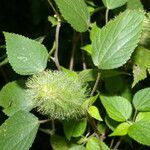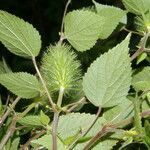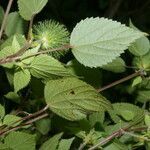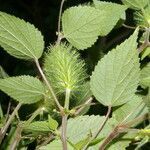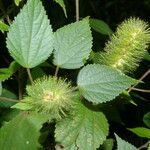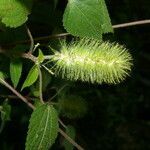Herbs, annual, 2–8 dm, monoecious. Stems erect to ascending, short-pubescent and densely [sparsely] hirsute. Leaves: petiole 0.5–4 cm, not stipitate-glandular; blade rhombic-ovate to rhombic-lanceolate, 2–9(–12) × 1.2–5(–6.5) cm, base cuneate to rounded, margins serrate, apex obtuse to acute. Inflorescences unisexual or bisexual, axillary; staminate peduncle 0.3–2.5 cm, not stipitate-glandular, fertile portion 1.5–3[–6] cm; pistillate peduncle 0.4–3 cm, not stipitate-glandular, fertile portion 2.5–4[–8] × 1–2 cm; bisexual similar to pistillate, with staminate portion 0.4–0.7 cm; allomorphic pistillate flowers common, terminal on pistillate and bisexual inflorescences. Pistillate bracts (normal flowers) very densely crowded (inflorescence axis not visible between bracts), 6–12 × 4–6 mm, abaxial surface long-hirsute (hairs to 2 mm) and stipitate-glandular; lobes 3–7, proximally deltate with linear tips, 1/2–2/3 bract length, smooth; of allomorphic flowers absent. Pedicels of allomorphic flowers rudimentary if borne above staminate flowers or 10–18 mm if borne above normal pistillate flowers. Pistillate flowers: pistil 3-carpellate (normal flowers), (1–)2-carpellate (allomorphic flowers); styles multifid or laciniate. Capsules smooth, hispidulous; allomorphic fruits ovoid, 1.5–1.6 × 1.2–1.3 mm, muricate, sparsely to densely puberulent. Seeds 1.1–1.5 mm, minutely pitted.
